
IBM Keyboards - The Odyssey Continues
Review date: 3 June 2005.Last modified 16-Jul-2012.
Regular readers, and numerous Googlers, will know that I've a certain affection for buckling spring keyboards. Primarily IBM buckling spring keyboards.
That's not because the IBMs have some magic key layout recipe nobody else can match (though some zealots are of that opinion; terrible and bloody have been the battles between the Function Keys To The Leftists and the Death To The L-Shaped Enter Keyites), but simply because they're easier to find than other keyboards that use the same super-durable, nice-feeling, alarmingly loud keyswitches.
(I'm producing the frantic storm of typing in the above-linked sound file; newcomers to buckling spring switches should know that they click when you depress the key and when you release it.)
IBM (or, you know, Lenovo, or whoever) don't make buckling spring keyboards any more. They sell various keyboards that use cheaper, quieter keyswitches that don't last nearly as long or provide nearly as pleasant a key-feel, but there's no real difference between current IBM-branded 'boards and any number of other mainstream offerings.
These mainstream 'boards, all with one or another variant of the simple and quiet rubber dome switch idea, are perfectly OK for people who don't type much. They may drop dead with or without the assistance of a spilled beverage, but that's no big deal; if your computer's essential to your happiness, buy a spare cheap keyboard in case your main cheap keyboard dies, and use your nasty mushy input devices with my blessing.
If you do type a lot, though, you owe it to yourself to get a good keyboard of one kind or another, for the same reason that people who use the mouse a lot shouldn't settle for some ancient crusty serial-port optomechanical artifact.
Old mouses aren't nice to use, but old keyboards can be, because mouse technology's advanced a lot over the last 20 years, but keyswitch technology was quite mature in 1980. Modern keyboard tech advances have mainly had to do with wireless interfaces, snazzy looks, and making cheap crud cheaper.
If you want to buy a new, as in manufactured-this-decade, buckling spring IBM keyboard, Unicomp is the place to go. They don't make 'boards with the actual IBM logo on them, but their products are the exact same thing as the later-model IBMs made by Lexmark (which is to say, not quite as monstrous as the original IBM-made units, with integrated cables instead of the plug-in originals, but still far beefier than mortal keyboards), and reasonably priced.
Among other things, they've got new basic 101 key 'boards for $US49 (plus shipping, which may be alarmingly expensive if you live outside the USA), the black version of the same thing for ten bucks more (the same price as this unusual object)
There is, however, also a thriving market for used and new-old-stock buckling spring 'boards. Because the things are so darn tough, it's quite common to find units that've seen hard service for longer than some people reading this page have been alive, and look as if you could grow potatoes in them, yet still work perfectly - and may have years of service left in them. The keycaps are easy to pop off, so it's easy to clean up an old 'board, and the moderate amount of elbow grease required to do so (not much at all, if you use the dishwasher) can leave you with a very good deal, provided you bought the keyboard from someone who (sensibly) thought that a dirty 20 year old piece of computer hardware couldn't possibly be worth more than a pack of smokes.
Old IBMs aren't guaranteed to work, of course. If you buy crates of them indiscriminately without testing them first, you'll be sure to find some with fractured cables or busted plugs, some that would appear to have been used by Oscar the Grouch for the last 36 years, some that're just stone dead for no immediately obvious reason, and many more that're mildly temperamental.
In my experience, senile buckling spring 'boards often develop intermittent key-bounce issues on frequently used keys like the space bar. That means you'll occasionally type two characters when you only hit the key once. This is mildly annoying for writers, but can be amazingly irritating for programmers.
Buckling spring keyswitches are, technically, replaceable - it's easy and cheap to replace lost keycaps or springs, and the whole keyboard can be torn down, with different degrees of ease depending on what model it is, to replace other parts. Most people just buy another 'board when they have a problem like this, though, and retire the twitchy one to the spares box, or onto the Server In The Corner.
And problems really aren't that common, even with used Model Ms of unknown provenance. If you pick up a box of five filthy as-is IBM keyboards at an auction for $13 (some people have found much better deals, and often insist on e-mailing me about them...), you can pretty much count on at least three of the 'boards working flawlessly for the next few years, after you shake the board chow out.
New-old-stock buckling spring keyboards are an even better bet than used ones. They don't go stale in the box. Unused "vintage" keyboards are often not nearly as cheap as used ones, of course, but that's what you pay to get a keyboard that's free of other peoples' germs.
The options
So. Basic dirty used Model Ms are cheap and probably good. Buy one on eBay from a seller in your country to avoid painful shipping prices; Model Ms have a steel plate in 'em and the basic version weighs about 2230 grams (4.9 pounds), unboxed. Regular keyboards often don't even make it to 900 grams.
If you want a new Model M, the going rate (ex shipping) for a recently-manufactured Unicomp 'board-with-no-Windows-keys-thank-you-very-much is $US49. Again, delivery may be excitingly expensive if you're outside the USA.
You may be able to find a new-old-stock Model M for less than this, but the only thing wrong with the new Unicomp ones is that they don't have the detachable cable that the original IBM keyboards had. They've got the same integrated cable as the later Lexmark Model Ms. For $US49 plus reasonable delivery, they're a fine deal.
So why buy a "vintage" 'board?
1: You can get the nice old ones with the plug-in cables, and look all cool in front of your nerd friends.
2: You can feel the heritage.
I'm not saying this is rational, or anything, but decades-old computing devices are, generally, rubbish. They may be of interest to the information technology equivalent of vintage radio collectors, but they're not actually objectively useful; the only vaguely sensible way to experience the original Spacewar these days is via emulation. But IBM keyboards still work, and you can easily make 'em work with every single computer on the market today, as we'll see shortly.
3: You can get weird stuff that isn't made any more.
Example:
This is an IBM Model M5-1; a regular Model M...
...with a ball. And four buttons - left, right, and two smaller ones that do left-and-hold and right-and-hold, to make click and drag operations easier.
Remove the ring around the trackball (not the easiest of feats on my review unit, but it'll presumably loosen up) and the mechanism's revealed; old-school optomechanical, of course.
This is a good optomechanical mechanism, though, with extra ball bearings to support the ball, and centre-ridged rollers that shouldn't accumulate crud all that fast.
You can buy a keyboard not unlike like this from Unicomp; they call it the On-The-Ball, and you can have it with buckling spring switches (yay!) or quiet rubber domes (boo!) for $US109, plus shipping. The On-The-Ball has its trackball up above the status LEDs at the top right, though; it's a remade IBM M5-2. That corner isn't the most convenient place it the world to put the ball; the older model nestles the mouse controls on a raised plinth above the cursor keys, which works much better.
This keyboard came from Clicky Keyboards (where else?), who sell them for $US85 to $US100, depending on condition. Cheaper ones are used, more expensive ones aren't. I got a brand new one. Nyaah.
I can't honestly say that a weeny trackball like this one is that much use for playing your classic arcade games - really, you need something at least a bit bigger.
But this ball's not nearly as awful as the tiny versions that adorned laptops back in the day; you really can use it perfectly well for normal cursor control, and you don't have to move your hand off the 'board to do it.
The first thing to replace awful little trackballs in laptops, though, wasn't the touchpad that most of them have now. It was IBM's own TrackPoint, released in 1992.
(No, it wasn't the HP Omnibook pop-out mouse; that came in 1993.)
The first TrackPoint was part of the first ThinkPad (it almost didn't make it). Similar widgets sprouted on other laptops, and mouses, and...
...Model M keyboards.
You gaze upon a ThinkPad-black buckling spring 'board
It's the model M13, and you're looking at $US95 ex shipping for one like this from Clicky Keyboards.
"Like this" means "not new". This keyboard of course works fine, and has had a quick brush-up, but there's still plenty of dust around the keys.
Unicomp sell M13s too; they call them the On-The-Stick, and one can be yours for $US99 plus shipping.
That's obviously an attractive deal, except for one thing - the Unicomp version is white.
Clicky Keyboards sell vintage TrackPoint 'boards in white and black; if you want white, you might as well get a new Unicomp one. But a TrackPoint on a white keyboard just ain't right.
Then again, Clicky Keyboards probably won't have a black M13 to sell you; they're rare, and I just soaked up one of 'em, so you may have to take extreme measures.
TrackPoints are even less suitable for games than little trackballs, of course. Oh, you can play your time-eating Shockwave games on 'em, but don't be surprised if you end up with a sore wrist.
(For the ultimate in flexibility, by the way, Unicomp will for $US149 sell you a 'board with a trackball and a TrackPoint!)
The M5-1 has a plug-in cable (I bet the Unicomp trackball keyboards don't); the M13's cable is integrated. Both cables end in a couple of normal PS/2 plugs, and you can plug in only one if you like. The keyboard doesn't need power for the pointing device to work, and vice versa.
How, though, do you use any Model M keyboard with a modern PC that doesn't have PS/2 ports?
Why, you use a PS/2-to-USB adapter, of course. They're commonly available. Easy as pie.
Or... not.
Model Ms aren't quite within the, um, popularly agreed envelope of the PS/2 specification. Most modern PS/2-ported motherboards will work with most old keyboards, but some 'boards need modifications. And some modern computers (coughDellcough) have out-of-spec USB ports that're well known to misbehave with all kinds of peripherals. And some PS/2-to-USB adapters combine the worst qualities of the most half-assed implementations of each interface.
Fortunately, Clicky Keyboards have sorted through several converters to find a couple that actually work with Model Ms. One keyboard-only, one keyboard-plus-mouse; $US15 and $US20 respectively.
(There are various other adapters on that page, including a $US8 metal-cased AT-to-PS/2 converter that not only looks better than the usual plastic ones, but ought to work better too, because it's shorter and should thus subject the little PS/2 socket to less leverage stress.)
This is the keyboard-only adapter, which comes in a totally brand-free blister pack but is, unlike most such super-generic yum cha hardware, actually as solid a little nugget as it looks.
I tried it out with a Model M and a Dell laptop; if it's going to screw up on anything, that's where it'll fail.
No problem. And no problem with any other computer I tried, either.
Other oddities
There've been plenty of other IBM keyboard variants over the years. "Space saver" no-keypad 'boards, ergonomic split keyboards, mini slimline 'boards with ThinkPad key modules in them (not buckling spring, but the best-feeling of the laptop keyboards, I think), 105-key Euro-boards, various higher key count industrial and commercial 'boards; the list goes on.
Clicky Keyboards will let you see, but not necessarily buy, pretty much all of them. If you want to actually buy something unusual, you'll have to fossick through the store and peek between the numerous "Sold" items.
If you just want to buy a regular vintage Model M, though, Clicky Keyboards tell me they've got scads (as in, hundreds) of new-old-stock units waiting to be sold - mainly the most-often-seen 42H1292 model, but they've also got stock of the M5-1 trackball 'board. You'll pay between $US60 and $US100, depending on model.
Hunt around the Clicky Keyboards store and you may also find old no-LED AT-plug 'boards (with PS/2 adapter) for $US60, the ultra-noisy original AT keyboard for $US130, an IBM-labelled Unicomp made only two years ago for $US70, and used, tested, "lightly surface cleaned" Model Ms about ten years old are $US35; five to ten bucks more for a keyboard about five years older
Oh, and if you're looking for replacement TrackPoint caps because your own red dot has become all polished and slippery, eBay is the place to go to get several for about a buck each - though IBM themselves will sell you non-standard TrackPoint caps, if that's the way you desire to roll.
And there are more bits you can buy, too. Clicky Keyboards have cables and spring assemblies, and clear keycaps, for instance; Unicomp have keyboard condoms.
Overall
There are competitors in the high-quality-normal-shaped-keyboard market, some of which are well worth considering. There are elegant options for persons over the fence in Macland, and Japanese Alps leaf spring enthusiasts, not to mention numerous variably weird alternative layouts, only some of which go the whole hog and make you chord. The field is also not without its shoestring innovators.
If you just want a regular noisy Model M or one of its intimately related descendants, though, you needn't spend ages searching.
It's not hard to find used IBM 'boards in questionable condition for $US10 plus shipping on eBay.
You're looking at about the same price for various old clicky terminal keyboards that can't be plugged into a PC, though. Clicky Keyboards mention this, and some other Things You Should Know, in their buying guide, which is worth reading even if you've no intention of buying anything from them.
Actually, the price doesn't even matter that much, for a buckling spring 'board in good condition. Five bucks, fifty bucks, $150 for some rare model - whatever you pay, your price-per-hour-of-use is likely to be minuscule, unless you do little enough typing that you didn't actually need such a keyboard in the first place.
This doesn't mean you should spend money for no reason, but it does mean you shouldn't stress over the price. Computer users are used to hardware that's worthless in three years and useless in five; clicky keyboards aren't like that. You could leave one of these things to your children in your will. Or be buried with it, like some kind of nerd Pharaoh.
I haven't decided which way to go with mine. Highly recommended.
You can find a wide variety of IBM keyboards on eBay; if all you want is an ordinary Model M in good condition that's not so far away that shipping triples its price, there are often good deals to be had.
Beware, however; some suspiciously cheap "model M" keyboards don't actually have clicky keyswitches. Also, "terminal" keyboards with some kind of registered jack or other non-PC connector are unlikely to be usable with a PC at all.
If it's got clicky switches and an AT or PS/2 plug, though, you're in business. Keyboards like this sell for less than $30 including US delivery all the time.
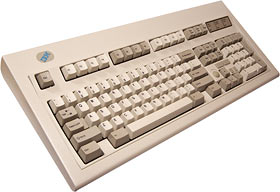
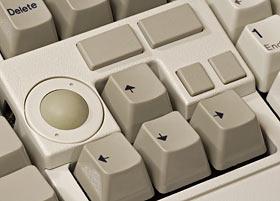

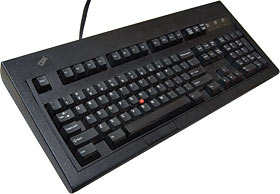
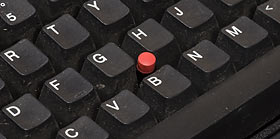
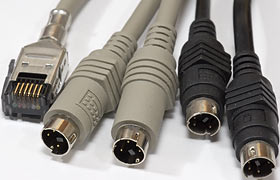



![[SecureWebs]](images/sw.gif)